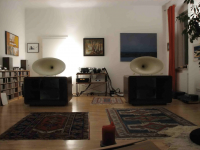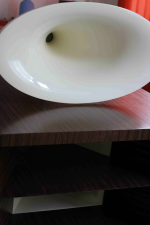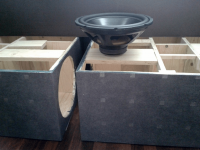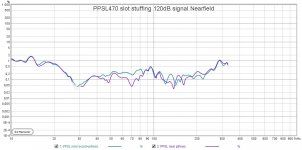Thanks! Learned a lot from a neighbor's '56 edition and 'Santa' brought me this '68 Edition when it came out that 'blended' well with the Altec info I'd started getting a few months earlier in that the latter was much more technical, so this and Badmaieff's book that same year became a sort of Rosetta Stone for me.a small (nostalgic) gift.
Camplo will particularly appreciate chapter 10
Yeah, IIRC my first 'dispute' on a forum pertained to dipoles and how to design them; really surprised me that an alleged speaker/horn designer couldn't seem to 'wrap his mind' around the simple concept that a horn was a folded up flat baffle, ergo to the first approximation to design one was to design the other. Oh well, guess it just depends on which 'angle' one's perspective is. 😉
Not me, it's just a simple variation on W.E.'s 'slot horn' throats in at least one of their huge cinema palace OB bass horns that according to the 'crusty' old EE that introduced me to the W.E. history was clearly superior it was presumably not incorporated in the Shearer system for cost considerations, but the concept lives on here except with just dual woofers on one side.That leads me to a question. Does anyone have any real technical qualms about a slot loaded woofer?
Just depends on one's POV in that I grew up at the large cinemas and live stage performances down low up front, so prefer mine up higher, angled down a bit depending on the system's design whereas many folks I've known that were in the balconies, further back prefer ear height or somewhat lower tweeters, though when on a vertical baffle often have XO's that tilt the polar response up a bit and with the Mantaray design, Altec offered the MR931-12 tweeter horn designed to mount tilt-up or down.Another thing that is bothering me, is my failure to keep the tweeter at ear level....I never anticipated such a large horn, and now I have over shot my height goals....I could re-engineer the cabs to a shorter height, if it really is that big of a deal to me... a ~37.5" stack of cabs would put the tweeter at ~47".... Much better than the 53" center tweeter height, I am looking at now.... I kinda feel like having tweeter, at ear height, is a huge part of the experience, a sort of unappreciated luxury?
Speaking from what I've read, not from real-world experience: the one that people seem to mention is the cavity resonance.Does anyone have any real technical qualms about a slot loaded woofer?
Some people have found push-pull helps resolve this: https://www.diyaudio.com/community/...rested-in-ppsl-enclosures.177905/post-2384657
Others seem to have found opposing woofers works better in their speaker configuration and that push-pull offers no huge benefit in terms of 2nd order harmonic cancellation for their speaker / driver. I think it depends on the size of the cavity, the depth, the motor design and the bandwidth in question.
I kinda feel like having tweeter, at ear height, is a huge part of the experience, a sort of unappreciated luxury?
Or a necessity?
From my experience with (mainly) radial horns a clearly discernible 'transition' between different sections of a system is very difficult to avoid/ignore, especially at short distances. This effect is more pronounced with long horns and direct radiators compared to full horn systems. The latter systems are obviously not feasible in average rooms.
Dual stacked PPSL would be interesting to say the least lol.... a MTM using PPSL would be very impressive in my opinion. Thinking out loud... If I remember correctly, @gedlee decided to keep the 15" in his 2way, above about ~100hz. I can appreciate that idea just by looking at an excursion plot of 15" diameter woofers.
I like the MTM concept.
15s above 80-100 Hz are common in PA > more on this later.
Last edited:
I certainly do as I mentioned before. I see no advantage and only disadvantages (chamber resonances, etc.) I would place the two 18s facing out rather than into a slot.Does anyone have any real technical qualms about a slot loaded woofer?
The woofers in my mains go all the way down to their closed box Fs. Below 100 Hz all of the LF sources (5 in stereo, 6 in multichannel) overlap with the subs phasing out with frequency as required by the final LF EQ.Thinking out loud... If I remember correctly, @gedlee decided to keep the 15" in his 2way, above about ~100hz. I can appreciate that idea just by looking at an excursion plot of 15" diameter woofers.
Hi Camplo, a few things.That leads me to a question. Does anyone have any real technical qualms about a slot loaded woofer? Personally, I think to keep this type of thing in the bass region, due to the lower resolution perceived at these frequencies. Yet Slot loading is the heart of Synergy Horns, and this takes place well into the upper midrange... The same blur (multiple peaks) in the IR will be there, maybe somewhat like a Tapped horn in ways. Maybe this is the reason for @mark100 's interest in the temporal EQing? If the synergy crowd is not having an issue, per say, using, multiple, slot loaded drivers in the upper mids, I am more confident about using a slot loaded woofer, in bass region, is what I am getting at.
First, i use the term slot loaded only for subs.
I think of slots you might see in synergys as ports, because they can take on any shape....they're essentially just shapes or holes in a horn wall, imo.
For subs, a slot to me means the entire driver is firing into a plenum that has as least as much area as the driver.
Push pull was supposed to offer some kind of HD reduction for marginal drivers. I tried it with good 18" drivers, and found no such reduction, only motor noise from a motor having to hang into the slot.
But I'd did find a remarkable reduction in cabinet vibration, so I kept the subs and use them in push-push. both facing into the plenum.
The width of the slot/plenum (1/4 wave distance between drivers) determines the highest frequency the sub is good for.
And yes, the slot creates too much response before that 1/4 wave frequency, that has to be knocked down. My steep filter strategy solves that easily.
The other drawback is two 18"s into the slot doesn't give quite the same amount of air push out into space, as two 18"s facing head on in regular boxes. Despite those drawbacks, the vibration reduction vs regular single boxes is very very nice. Only subs I've ever had/seen that I could set a glass of wine on.
No cabinet noise cranking hard.
For synergys, I recently put two 18"s inside one, each one firing through ports sized to total 1/8th Sd.
Worked great. The acoustic low pass, in addition to 96dB/oct low-pass @100Hz gave probably the cleanest low frequency i've ever heard.
I measured sensitivity compared to a sealed box, and after EQ/processing, the average sensitivity across the 30-100Hz bandwidth was close to the same. So, no problem with ports I think.
What was a little eerie, was hearing a true sub wrapped around a CD like a coaxial, (along with wrapped lows and mids). Strange hearing the full spectrum as a point source, I didn't think it would make a difference from my usual syns sitting on subs. Took a little getting used to, but it grew on me pretty quick.
Talk about slam and punch. It reinforced my opinion i like one good sub the most, then two for stereo, then 3 for LCR, then stop !! lol
Temporal EQ...as Fulcrum portrays, is about CDs and horns, catching horns discontinuity reflection back into the throat/CD electrically in the time domain, the way foam in the throat catches them mechanically. But imo, it's just another name for cleaning up impulses with FIR.
For synergys, I recently put two 18"s inside one, each one firing through ports sized to total 1/8th Sd.
Worked great. The acoustic low pass, in addition to 96dB/oct low-pass @100Hz gave probably the cleanest low frequency i've ever heard.
I measured sensitivity compared to a sealed box, and after EQ/processing, the average sensitivity across the 30-100Hz bandwidth was close to the same. So, no problem with ports I think.
What was a little eerie, was hearing a true sub wrapped around a CD like a coaxial, (along with wrapped lows and mids). Strange hearing the full spectrum as a point source, I didn't think it would make a difference from my usual syns sitting on subs. Took a little getting used to, but it grew on me pretty quick.
Talk about slam and punch. It reinforced my opinion i like one good sub the most, then two for stereo, then 3 for LCR, then stop !! lol
Mark, this reminds me of a variation on the J1-94. Do you happen to have pictures of this synergy horn?
Here ya go, the white one. . The blue horn on top is one of my normal LCR setup (that i robbed the CD out of for the white guy).
White is 45" wide, 75x60 pattern.

White is 45" wide, 75x60 pattern.
I have a 2x15" PPSL subwoofer. Definitely the port nearfield measurement gives nice spl, but area is smaller than 2x15" drivers. This means cavity noise, turbulence with high spl. The problem is that I can measure it only indoors, because it is a part of furniture in my HT room. Red line is nearfield without eq or xo, other lines are room responses at various spots. Same input voltage.

Synergy horn slots are different story, because of the horn.
Test of a slot loaded multidriver subwoofer. Nulling at 138Hz https://data-bass.com/#/systems/5aa4a25261feb10004121e18?_k=sqkbuj
Synergy horn slots are different story, because of the horn.
Test of a slot loaded multidriver subwoofer. Nulling at 138Hz https://data-bass.com/#/systems/5aa4a25261feb10004121e18?_k=sqkbuj
This is similar to what I was envisioning, at least in ways. The slot resonance...is it really an issue? Maybe it is per design? When I look the sim from hornresp I feel that the resonant note is not significant enough to be noticed.
After eqing, the decay will become even more smooth, not to mention that the 200hz XO attenuates -6db from that area.
For example;(Below) dealing with something going on at at about 10-12ms sub -20db.....thats nothing right?
I think that decay improves further in real life...As much as I want to post some actual measurements, I will wait until I take them outside. Approximately where the slot resonance is depicted in the above graphs, there is a room mode. I just spent the better part of an hour playing with the ppsl and 15" midwoofer..... The slot resonance does not seem to have some type of exaggerated decay per say.... If I A/b within the area of interest using the 15 vs ppsl, volume matched....theres no significant difference in decay, that I can readily tell at least...Funny enough, the 15" is more into the room mode than the ppsl is within the area of approximately 130-160hz. The 15" sounds more roomy, but closer to the floor is known for better room response isn't it. I am just having a hard time hearing the exaggerated decay and if the simulation is ball park correct, theres not much to listen for after the voicing the driver in a more neutral way. I only look at the exaggerated decay as an issue since the FR issue can be fixed with EQ and the Decay issue only mitigated. It may be possible that the rising midrange sensitivity of the 18H+ softens Q of the Peak? Or maybe the low Qts???
Look at what 18" ultimax does in the slot;
Maybe the above is why some drivers work better in a horn???
At this point I am thinking that the slot resonance is not an issue. I think an outside measurement will seal the deal, as far as figuring out decay, but I can say from experience that I have not had issue smoothing the FR and I cannot easily detect any exaggerated decay due to the slot itself.
I started off with the stress testing of the PPSL crossed at 200hz.... I can make it distort the content that is towards the XO point but it is somewhat hard to hear...meaning there is distortion with the right material and high volume as in towards 106db-108db average at my ~45" listening point. Only a critical listener like us would pick it out...and if I hadn't of turned the horn off, it would of been less obvious. I tried using REW's dual tone at 20-30hz vs 200hz. Amplitude distortion took more excursion from the lower tones than one would think, to get a significant effect at 200hz. IN music, I could sense compression of the content near the XO during some of the high excursion low bass notes. It should be noted that in combination of high volume, I had to find the right low bass songs with some strong enough content near ~200hz to create a noticeable effect.
These are good things.
I think of slots you might see in synergys as ports, because they can take on any shape....they're essentially just shapes or holes in a horn wall, imo.
The holes or ports in walls of the horn are definitely a slot loaded driver....A slot loaded driver is just a driver firing into line, from the side of the line, instead of from the beginning of the line. There is a cancellation and resonance, for each side firing port in a synergy is what I am suggesting. Its of course not identical to a PPSL. There are just similarities, but the point I was making is that a slot loaded driver will create multiple peaks in the IR just like a PPSL and even a taped horn. The fact that such a flaw is used in midrange is interesting.Synergy horn slots are different story, because of the horn.
For example my sim PPSL;
One peak is for the driver and another for the major reflection from the inside/backwards firing signal reaching the beginning of the line and then returning. The IR of any side firing port in the synergy will have resemblance.... As tapped horn has proved, this type of trait can he hidding with the low timing expections of bass. Midrange?....shrug
lol yeah the slot cancellation....The acoustic low pass,
This is exactly what I was talking about here;What was a little eerie, was hearing a true sub wrapped around a CD like a coaxial, (along with wrapped lows and mids). Strange hearing the full spectrum as a point source, I didn't think it would make a difference from my usual syns sitting on subs. Took a little getting used to, but it grew on me pretty quick.
The same type of thought crossed my mind, just, in my case, covering 20hz-200hz as a point source. In my case, limited to 200hz from the tweeters axis, its almost a step backwards to add another point source above the PPSL that cannot cover the same bandwidth vs just handing over to the tweeter. If all things else are equal, losing any bandwidth is a loss of SQ, and the PPSL is matching or beating the single PPSL 200hz and below.. The aspect of SQ that it presents, is one that I did not anticipate, the SQ aspect known as bandwidth....Silly for me to not consider it, since I have been chasing this low tweeter XO point
Last edited:
What do you mean by this?This means cavity noise, turbulence with high spl.
Attachments
Air movement is causing noise (chuffing), typically noticed with bass reflex ports. With high Sd drivers and smaller port area (slot) this happens too. In theory, but actually I don't beleive it becomes a problem with loudspakers used indoors at home - but with PA outdoor systems.
But this thread seems to drive people to extremities...
The pic above is of my PPSL sub, without the cover. I stuffed two pillows between drivers and the wall behind them, to minimize cavity volyme (to shift first resonance higher in F) and to suppress cavity resonance amplitude. I didn't even take measurements without stuffing! I checked it now, and noticed that the piece of cardboard is still there. I forgot to take it off... since April 2013!

But this thread seems to drive people to extremities...
The pic above is of my PPSL sub, without the cover. I stuffed two pillows between drivers and the wall behind them, to minimize cavity volyme (to shift first resonance higher in F) and to suppress cavity resonance amplitude. I didn't even take measurements without stuffing! I checked it now, and noticed that the piece of cardboard is still there. I forgot to take it off... since April 2013!

View attachment 1127527
This is similar to what I was envisioning, at least in ways. The slot resonance...is it really an issue?
The Haigner Alpha horn is a 3-way 'time-aligned' concept (103 dB / W / m and 8 ohm imp.) with 2x 18" woofers in a (compact) front-loaded bass horn configuration + elliptical CD horn with BMS 4590 Coaxial. The horn mouth is divided into 2 parts, separated by a kind of phase plug/splitter.
Viewed from the front, the left woofer loads the top section.


I like the concept, but it needs at least 40m2 to breath.
Btw, it seems the chamber is ported.
Last edited:
View attachment 1127587
Maybe the above is why some drivers work better in a horn???
Key enabler is the motor.
The Bl factor of the dual 6" coil 24" driver, co-developed with Precision Devices, in this horn sub is 50:
It's definitely not infrabassfähig 😉 > impossible given the dimensions.How low does that Haigner bass horn go ?
Regards
Charles
Listening impressions (in German).
Last edited:
- Home
- Loudspeakers
- Multi-Way
- Is it possible to cover the whole spectrum, high SPL, low distortion with a 2-way?

